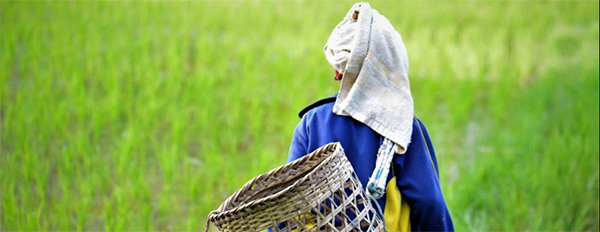Huay Ee Khang Village in Mae Win Sub-district of Mae Wang District in Chiangmai is piloting an effort to use its community forest of 60 rai (9.6 hectares) to become an “Indigenous “Women’s Forest” emphasizing varieties of plants for herbal medicine, natural dyes for cloth, and food crops. This idea aims to create a natural classroom for Indigenous Knowledge transmission amongst Pgakenyaw girls and women and to generate supplementary income in the future.
Noraeri Thungmueangthong, a village chief and prominent leader of the Indigenous Women’s Network of Thailand (IWNT), has initiated this project with the idea of creating a forest for Indigenous Women. This was inspired by the Pgakenyaw traditional classification of forest as Keu Neu, which categorizes two types of forest: Keu Neu Mue (hill evergreen forest or Women’s Forest), and Keu Neu Pha (rainforest or Men’s forest). With this interpretation, Noraeri has in mind to create a living Indigenous Women’s Forest accessible to housewives and young girls in particular. This Indigenous Women’s Forest of 60 rai is located about 2 kilometers from the village. On July 1st 2016, additional plants were introduced into the Forest for the first time. Later on, more indigenous species were added every year. These practices allow for easier and more convenient access for the gathering of non-timber forest products (NTFP), such as, sappan wood used for traditional cloth dying.
The Forest is cared for by the women and serves all beneficiaries. It provides food as well as herbal plants for everyone in the community. There are plants for Ow Meh Oo Thi, herbal medicine for babies and elderly people, wild fruits for children, ingredients for indigenous cuisine, etc. In addition, the Indigenous Women’s Forest can also feed small and larger animals with fruits, e.g. fig and banyan trees.
The idea has been put into practice for three years and now one can see the positive results. Noraeri anticipates that next year the planted bamboo plants will grow to the extent that villagers can make use of their products. Sappan wood is useful to the women’s weaving group in the dying of cotton thread. She expects that over the longer term the Indigenous Women’s Forest will be the major source of NTFPs, especially from the sale of bamboo for rafting services on the Mae Wang waterway.
Apart from the Indigenous Women’s Forest, Huay Ee Khang Village also implements interesting natural resource management (NRM) via a number of activities mostly based on the revival of customary practices of the Karen people. For example, De Paw Thoo forest (Umbilical Forest) is a unique practice among the Karen people wherein the umbilical cord of a newborn baby placed in a bamboo container is hung on a healthy tree; and, thus, the souls of the baby and the bamboo tree are intertwined throughout their lifespan, and no one can cut this tree. Such practices can be regarded as the group’s stratagem for forest conservation and the survival of
both people and nature. This strongly illustrates the indigenous philosophy of equilibrium. It is the duty of a father to identify a healthy tree for hanging the umbilical cord of his baby, with the tree type able
to bear fruit. Huay Ee Khang village has identified a certain area as De Paw Thoo forest and as a learning site for younger Karen and outsiders.
Huay Ee Khang not only gives importance to forest conservation, but also water management based on the indigenous belief system. The community has also revived the extension of life of water, or Sue Thee Anee (a Karen ritual) to express gratitude and apologize to the water spirit as well as asking for blessings from the spirit. The basic idea is to protect the water from any kind of damage. Thus, the community has demarcated a fish sanctuary for about three kilometers along the Mae Wang waterway. All kinds of fishing are strictly prohibited, and small fish are released into the stream from time to time. There was a crisis about ten years ago when groups of outsiders came into the area and electrocuted fish in great numbers which almost wiped out all water creatures. Because of that, the community developed regulations for the protection of lives under water, accompanied by ritual performances and control of natural resources based on indigenous knowledge.
For more information please contact:
This email address is being protected from spambots. You need JavaScript enabled to view it./This email address is being protected from spambots. You need JavaScript enabled to view it.

